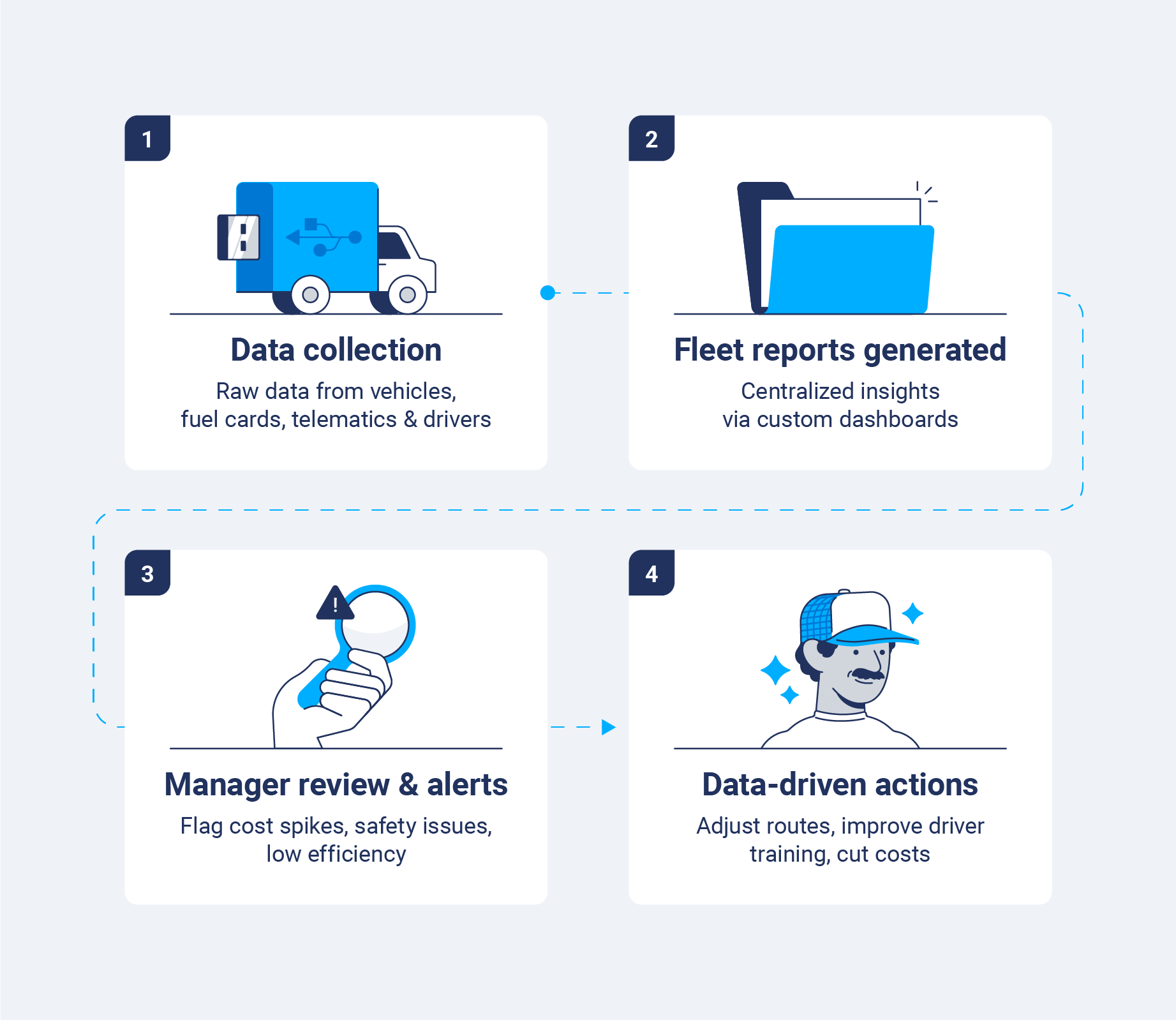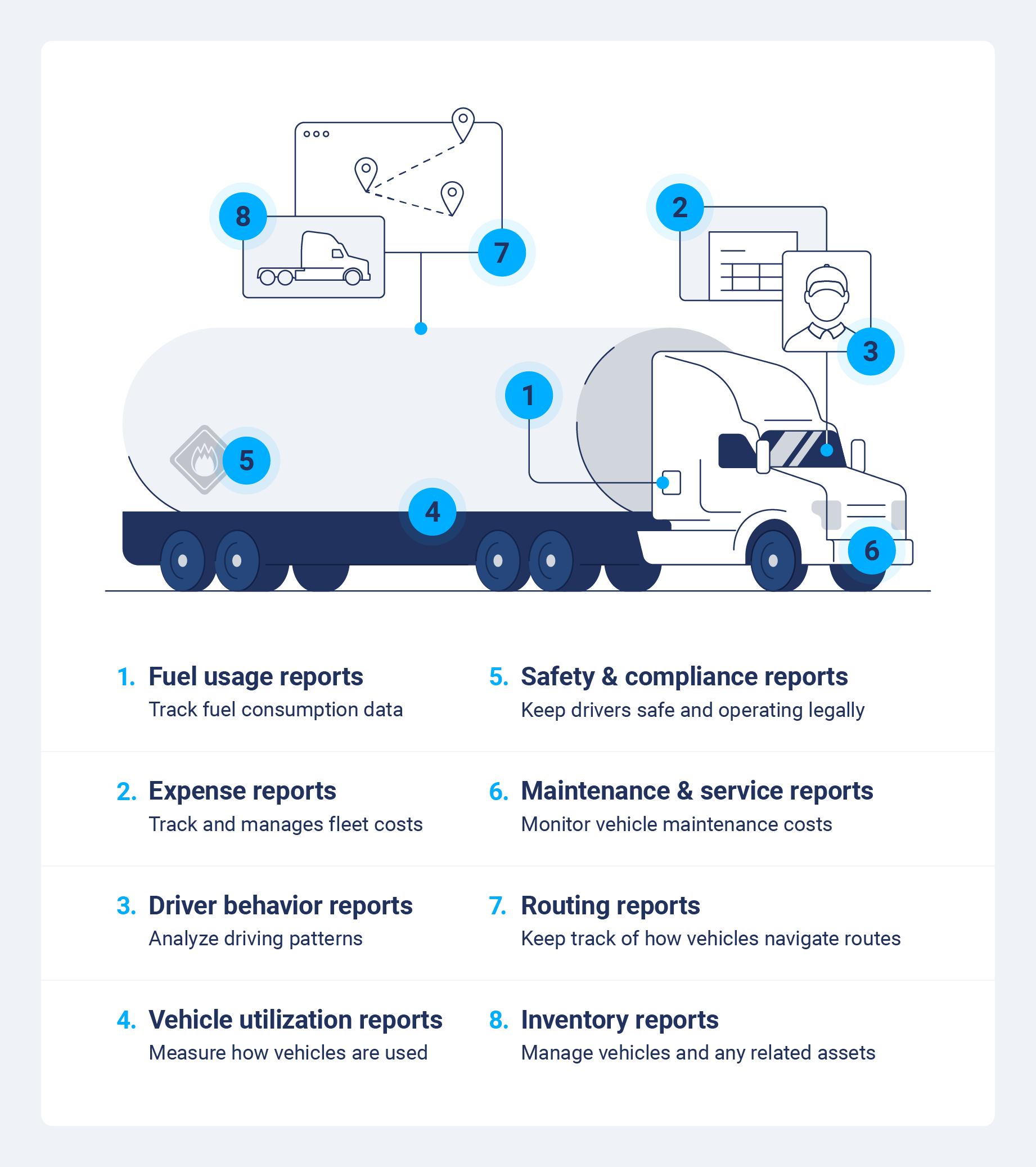Fleet management reporting: Driving your fleet further with actionable insights + automation
Fleet management reporting is the systematic collection and analysis of vehicle and driver data that tracks key metrics like fuel consumption, maintenance costs and driver safety scores through reports like performance dashboards and compliance summaries.
By Geotab Team
Jul 16, 2025

Key Insights
- Fleet management reporting refers to the collection, organization, analysis and reporting of a vehicle fleet’s vital information.
- Common types of reports include fuel consumption, maintenance and vehicle utilization.
- Key metrics to track cover fuel efficiency, vehicle utilization rate, driver behavior metrics and maintenance costs per vehicle.
Keeping track of a fleet of vehicles is no easy feat. Improper reporting on fleet activities can lead to the loss of thousands of dollars every year. That’s why fleet management reporting is a must-have for any organization.
Fleet reporting keeps all of your relevant data in one place, making it easy to:
- Manage operational costs
- Optimize maintenance spend
- Boost worker productivity
- Meet compliance standards
- Improve driving habits
Proper reporting can reduce collision rates by 40% by ensuring drivers follow all proactive safety measures. Read on to learn exactly what fleet reports are, the most important types of fleet reports you should be running, the benefits of using them and the best tools on the market.
What is fleet management reporting?
A fleet management report is a collection of data points that give you complete visibility into your fleet’s performance, costs and operational needs.
These reports consolidate critical information across multiple sources, like telematics systems, fuel cards, maintenance records and driver behavior data, into organized, easy-to-use dashboards. Learning how a fleet management system works is key to driving long-term strategy and day-to-day operations.
Well-executed fleet reporting means managers can stop being reactive and start being proactive, making data-driven decisions to improve efficiency and profitability. Modern fleet reports often use telematics to provide real-time insights into vehicle health, fuel consumption, route efficiency and driver performance.

Centralizing all fleet data into clear, accessible reports can make all the difference. It means managers can keep track of key performance indicators, create clear benchmarks, demonstrate ROI and identify potential problems before they become expensive issues.
Types of fleet reports
There are several types of reports that fall under the fleet management reports umbrella. Each offers insight into different areas of performance, cost and compliance. Most are generated using your telematics system and can be customized based on your goals.
Learn more about the most common types of telematics reports below.
1. Fuel usage reports
A fuel usage report tracks and analyzes fuel consumption data for all vehicles, providing insights on fuel cost, efficiency and areas for improvement. It’s best used to identify trends like which vehicles or drivers are the most or least efficient with fuel consumption.
Fuel usage reports include information like:
- Gallons of fuel used per vehicle or driver
- Vehicle and driver information
- Miles per gallon used
- Fuel costs
- Fuel purchase dates and amounts
- Refueling locations and frequency
- Idle time affecting fuel use
- Historical fuel usage comparisons
2. Maintenance and service reports
Maintenance and service reports track total fleet maintenance costs. Keeping every vehicle running smoothly means maintaining meticulous records, especially if your fleet is made up of EVs and standard vehicles, which have different needs.
Maintenance and service reports include data points like:
- Routine maintenance costs (oil changes, tire rotations, etc.)
- Repair and parts costs
- Maintenance and repair labor costs
- Downtime costs while the vehicle is out of service
- Maintenance costs per hour, mile, or other unit of measurement
3. Driver behavior reports
Driver behavior reports keep track of how drivers operate a vehicle using tools like behavior monitoring software or telematics systems, which review actions in real time. These reports help improve safety and efficiency and can even reduce fleet management needs and individual driver costs.
Driver behavior reports monitor metrics like:
- Speed
- Acceleration
- Braking
- Cornering
4. Vehicle utilization reports
Vehicle utilization reports show how often vehicles are used, for what purpose and other metrics like engine and idle time. This type of fleet management report aims to identify fleet asset utilization and improve operational efficiency. Underused vehicles might be sold or leased or added to different routes, while overused vehicles might get increased maintenance.
Common metrics used in a vehicle utilization report include:
- Driving distance
- Total time the vehicle’s engine is running
- Total time the vehicle’s engine is idling
- Total time the vehicle is in motion
- Power take-off time

5. Safety and compliance reports
Safety and compliance reports are key to keeping vehicles and drivers safe and in legally operating condition. These reports are designed to improve overall fleet efficiency by analyzing driver behavior, vehicle maintenance and regulatory adherence.
Common examples of safety and compliance reports include daily or weekly vehicle inspection reports and fuel consumption reports that identify opportunities for improvement. Driver behavior reports that track spending and harsh braking fall under both the safety and operational reports performance. Many fleet reports overlap categories, providing insights that support a wide range of fleet management needs.
This type of fleet data management typically includes metrics such as:
- Accident data and other incident reporting
- Fuel consumption
- Regulatory compliance
- Vehicle maintenance schedules
- Vehicle emissions
6. Expense reports
Expense reports track and manage fleet costs, including repair, fuel and other maintenance-related costs. This data is best used to identify cost reduction opportunities and other areas to improve fleet performance.
Expense reports include information on:
- Vehicle repair costs
- Fuel costs
- Operational expenses
- Routine maintenance expenses (parts, labor, warranty costs)
- Vehicle utilization
- Vehicle identification
- Date of service or repair for each vehicle
7. Routing reports
Fleet management routing reports keep track of how your vehicles navigate each route. These reports use GPS to track vehicle location, driver behavior and route efficiency. The data is key to providing timely deliveries and finding the most efficient routes for deliveries, pickups and service calls.
Routing reports include data points like:
- GPS coordinates of vehicle location
- How closely vehicles follow planned routes
- Arrival and delivery time
- Geofencing alerts when vehicles enter or leave pre-defined areas
- Amount of time vehicles dwell at specific locations
- Driver behavior
- Safety incidents
- Deviations from planned paths
8. Inventory reports
Inventory reports are the best way to track and manage your vehicles and any other related assets. They provide much-needed insights into fleet costs, making it easier to optimize spend and maintain inventory.
Inventory reports provide insights into data like:
- Maintenance schedules
- Fuel management
- Real-time vehicle location
- Driver behavior
- Inventory levels for tools, parts and other supplies
Strategy benefits of fleet management reporting
Fleet management reporting isn’t just about collecting data — it’s your secret weapon for transforming fleet operations while slashing costs. When you can track and analyze vehicle performance, driver behavior and operational patterns, you unlock the ability to make smart, data-driven decisions that boost maintenance efficiency, optimize fuel consumption, streamline routes and so much more.
Think of it as turning your fleet’s big data into your biggest competitive advantage, getting the insights you need to stay ahead of problems before they hit your bottom line.
Ready to see how your fleet compares to industry benchmarks? Download our State of Commercial Transportation Report to discover key trends, performance metrics and strategies that can optimize your fleet operations.
Improved operational efficiency
When you have driver and vehicle data at your fingertips, you can instantly identify the most fuel-efficient routes for your fleet and streamline your entire workflow. This kind of data-driven optimization doesn’t just save fuel costs — it transforms workplace productivity by making sure every mile driven and every minute spent adds to your bottom line.
Cost reduction
Fleet reporting makes cost reduction simple by identifying waste. Managers can quickly spot fuel-guzzling or easily broken vehicles, wasteful driving patterns and poorly optimized operations.
Knowing where your money is getting thrown away makes it easy to offset with new vehicle purchases and driver training. Safety improvements from better reporting can even help you earn insurance discounts through telematics data, creating additional cost savings that compound over time.
Increased safety and compliance
With regular monitoring, you can easily manage the complex demands of safety and compliance by reviewing a dashboard. Fleet reporting means you don’t have to keep up with ever-changing regulations like hours of service (HOS) for your commercial drivers. Comprehensive fleet safety programs handle the heavy lifting for you, so worrying about fines can become a thing of the past.
Real-time monitoring also means you can quickly identify and address dangerous behaviors, reducing the risk of accidents and improving overall driver safety. When incidents do occur, advanced telematics data can even help with collision reconstruction, giving you valuable insights that can help prevent future accidents and protect your organization from liability issues.
Predictive maintenance scheduling
Data analysis, predictive modeling and sensor technology allow you to anticipate and proactively schedule vehicle maintenance, leading to fewer unexpected repairs and less downtime. Use fleet management reporting to schedule predictive maintenance during off-peak hours and when it’s most convenient for you, fully optimizing your resource allocation.
Real-time visibility
Your fleet management systems’ GPS and telematics setup enable you to constantly track and monitor your vehicles for complete real-time visibility. You'll enjoy improved route planning, better communication with your drivers and increased accountability when it comes to issues like speeding or unauthorized vehicle use.
Data-driven insights
Fleet management reporting transforms scattered information into powerful, actionable intelligence. You’ll have all vehicle and driver data at your fingertips 24/7.
With comprehensive fleet data analytics, managers can make informed, strategic decisions about everything from vehicle replacement timing and resource allocation to route optimization and driver coaching opportunities. You can keep tabs on critical KPIs like fuel efficiency, maintenance costs, driver safety metrics and operational efficiency, spotting improvement opportunities with ease.
But the real power of fleet reporting data lies in its ability to provide context and benchmarking. You can compare your fleet’s performance against industry standards, identifying your opportunities for wins and areas for growth.
You can even use historical trends to predict future needs. This level of insight means you can build out long-term fleet strategy and data-backed investment decisions.
Automate your fleet management reporting with Geotab
Managing your fleet without proper reporting is like driving blindfolded. You might get somewhere, but you’ll be wasting serious time, money and resources along the way. That’s why automated fleet management reporting is such a game-changer.
Instead of your team manually collecting data from multiple sources and spending hours generating reports, Geotab does the heavy lifting for you, automatically capturing vehicle data, driver behavior metrics and operational insights into an easy-to-use dashboard.
Thanks to Geotab’s automated report generation, you can turn raw telemetrics data into actionable insights. You can get continuous monitoring of:
- Fuel consumption
- Vehicle maintenance
- Driver safety scores
- Route efficiency
The real power of Geotab’s automated reporting lies in its ability to give you foresight. You don’t need to react to vehicles suddenly being put out of commission; instead, you can forecast maintenance and fuel efficiency strategies. These automated insights keep you ahead of challenges while maximizing your fleet’s performance and profitability.
Ready to transform your fleet management report? Geotab’s integrated reporting solution means no more guesswork or manual data collection. Get the data-driven insights you need for a fleet management solution that optimizes operations, fuel usage, route selection and driver behavior across your entire fleet.
Subscribe to get industry tips and insights
Frequently Asked Questions
While specific metrics can vary based on the type of fleet report, most include data points like driver behavior, mileage, idle time, maintenance costs, service history and compliance.
Common fleet management KPIs include fuel efficiency, cost per mile, total cost of ownership, maintenance costs and driver safety.
A fleet manager reports to upper management, such as a director, vice president or other senior executive.
Fleet management audits usually involve reviewing vehicle maintenance, driver safety, fuel consumption, operational efficiency and compliance needs to optimize performance and reduce costs. Fleet managers can either conduct these audits internally or outsource them to third-party specialists for a more objective assessment.
The Geotab Team write about company news.
Table of Contents
Subscribe to get industry tips and insights
Related posts

The $4B Crisis: Video Intelligence as the Answer to Fleet Distraction
December 2, 2025
3 minute read

The True Cost of Cargo Theft: When Customer Trust is on the Line
November 24, 2025
2 minute read

Telematics device cost: Key factors that determine pricing
November 19, 2025
5 minute read

Law enforcement technology: Four trends to know for 2026
November 7, 2025
6 minute read

Four seasons of fleet intelligence with Geotab's Public Works solution
November 7, 2025
2 minute read

Infographic: What are the ripple effects of school bus driver turnover?
November 6, 2025
1 minute read